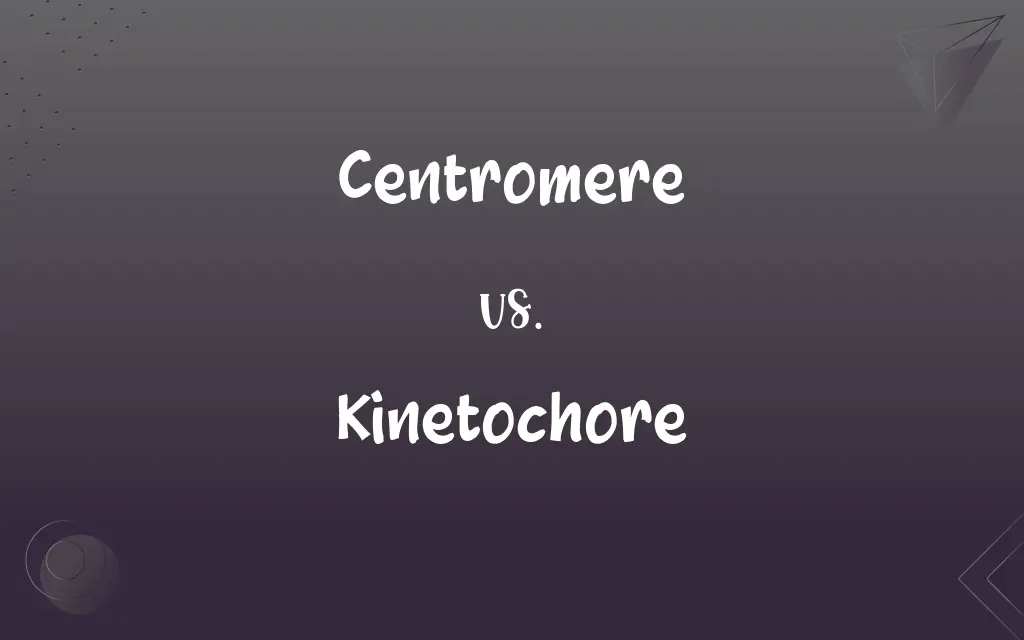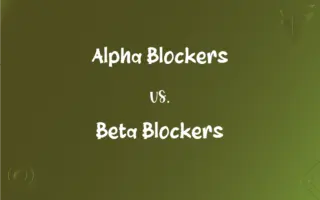Centromere vs. Kinetochore: What's the Difference?
Edited by Janet White || By Harlon Moss || Updated on October 28, 2023
The centromere is a DNA region where sister chromatids are held together; the kinetochore is a protein structure on the centromere that connects to spindle fibers.

Key Differences
The centromere and kinetochore are both essential components in the process of cell division. The centromere is a specific region of the DNA where the two sister chromatids are closely held together, ensuring they move as a single unit during cell division. On the other hand, the kinetochore forms on the centromere and serves as the main attachment point for spindle fibers.
In a chromosome, the centromere plays a critical role in maintaining the structure and ensuring proper segregation. Without the centromere, the sister chromatids wouldn't stay connected, leading to potential errors in cell division. The kinetochore, directly associated with the centromere, ensures that the spindle fibers, which pull the chromatids apart, have a firm anchor point.
While the centromere is a specific DNA sequence, the kinetochore is more about function than sequence. The kinetochore is a complex protein structure that assembles on the centromere, acting as the bridge between the chromosome's DNA and the cell's microtubules.
The centromere's location can vary on a chromosome - it can be central (metacentric), off-center (submetacentric), at the very end (telocentric), or near one end (acrocentric). The kinetochore, however, will always be found at the centromere, regardless of the centromere's position on the chromosome.
Both the centromere and kinetochore are critical for ensuring genetic material's accurate distribution to daughter cells. The centromere holds the genetic material together, while the kinetochore ensures its correct alignment and movement during cell division.
ADVERTISEMENT
Comparison Chart
Nature
DNA region
Protein structure
Role
Holds sister chromatids together
Connects centromere to spindle fibers
Composition
Specific DNA sequences
Complex of proteins
Location on Chromosome
Can be central, off-center, at the end, or near one end
Always on the centromere
Function in Cell Division
Ensures chromatids move as a unit
Ensures accurate alignment and movement of chromatids
ADVERTISEMENT
Centromere and Kinetochore Definitions
Centromere
A specific DNA sequence on chromosomes.
The gene's location relative to the centromere can help in mapping studies.
Kinetochore
Essential for proper chromosome movement.
The kinetochore ensures chromosomes are pulled to opposite cell poles.
Centromere
Can vary in position on a chromosome.
The chromosome's centromere position determines its shape and classification.
Kinetochore
Connects chromosomes to spindle apparatus.
Without the kinetochore, chromosomes wouldn't align properly during cell division.
Centromere
Critical for maintaining chromosome structure.
The centromere's integrity is vital for the chromosome's stability during replication.
Kinetochore
Facilitates accurate chromosome segregation.
Anomalies in the kinetochore can lead to errors in cell division.
Centromere
The region where sister chromatids attach.
The centromere ensures chromatids stay together during cell division.
Kinetochore
Directly interacts with microtubules.
The kinetochore's protein components bind to microtubules, ensuring a firm grip.
Centromere
Essential for chromosome segregation.
Without the centromere, chromosomes could be distributed unevenly during cell division.
Kinetochore
A protein complex on the centromere.
The kinetochore provides an anchor for spindle fibers during mitosis.
Centromere
The most condensed and constricted region of a chromosome, to which the spindle fiber is attached during mitosis.
Kinetochore
Either of two submicroscopic attachment points for chromosomal microtubules, present on each centromere during the process of cell division.
Centromere
(genetics) The central region of a eukaryotic chromosome where the kinetochore is assembled.
Kinetochore
(biology) The protein structure in eukaryotes which assembles on the centromere and links the chromosome to microtubule polymers from the mitotic spindle during mitosis.
Kinetochore
A specialized condensed region of each chromosome that appears during mitosis where the chromatids are held together to form an X shape;
The centromere is difficult to sequence
FAQs
What is the main role of the centromere?
The centromere holds sister chromatids together on a chromosome.
Can a chromosome exist without a centromere?
No, the centromere is crucial for chromosome structure and segregation during cell division.
Is the centromere made of protein or DNA?
The centromere is a specific DNA region on a chromosome.
What composes the kinetochore?
The kinetochore is a complex structure made of proteins.
How many kinetochores are present on a chromosome?
A chromosome has two kinetochores, one on each sister chromatid's centromere.
How do spindle fibers interact with chromosomes?
Spindle fibers attach to chromosomes via the kinetochore on the centromere.
Can the centromere's position vary on a chromosome?
Yes, the centromere's position can vary, classifying chromosomes as metacentric, submetacentric, acrocentric, or telocentric.
Do all organisms have centromeres?
All eukaryotic organisms have centromeres, essential for cell division.
Does the kinetochore play a role in meiosis?
Yes, the kinetochore is also vital for chromosome movement and segregation during meiosis.
What would happen without a centromere?
Without a centromere, sister chromatids wouldn't stay together, leading to cell division errors.
Are there any diseases associated with kinetochore dysfunction?
Yes, defects in kinetochore function can result in aneuploidy, which is linked to several diseases, including cancer.
How does the kinetochore function in cell division?
The kinetochore connects the centromere to spindle fibers, ensuring proper chromosome movement.
Does every chromosome have one centromere?
Yes, every chromosome has one centromere.
What happens if the kinetochore doesn't function properly?
Malfunctioning kinetochores can lead to errors in chromosome segregation, potentially causing genetic disorders.
Is the centromere involved in genetic disorders?
Abnormalities in centromere function can lead to improper chromosome segregation, contributing to genetic disorders.
Where is the kinetochore located?
The kinetochore forms on the centromere of a chromosome.
How does the centromere help in cell division?
The centromere ensures sister chromatids stay together and segregate properly.
Why is the kinetochore vital during mitosis?
The kinetochore ensures accurate chromosome alignment and movement by connecting to spindle fibers.
Can the centromere's position help in genetic mapping?
Yes, the gene's relative position to the centromere can be useful in genetic mapping.
Why is the kinetochore's protein composition significant?
The protein composition allows the kinetochore to bind firmly to microtubules and ensure chromosome movement.
About Author
Written by
Harlon MossHarlon is a seasoned quality moderator and accomplished content writer for Difference Wiki. An alumnus of the prestigious University of California, he earned his degree in Computer Science. Leveraging his academic background, Harlon brings a meticulous and informed perspective to his work, ensuring content accuracy and excellence.
Edited by
Janet WhiteJanet White has been an esteemed writer and blogger for Difference Wiki. Holding a Master's degree in Science and Medical Journalism from the prestigious Boston University, she has consistently demonstrated her expertise and passion for her field. When she's not immersed in her work, Janet relishes her time exercising, delving into a good book, and cherishing moments with friends and family.































































